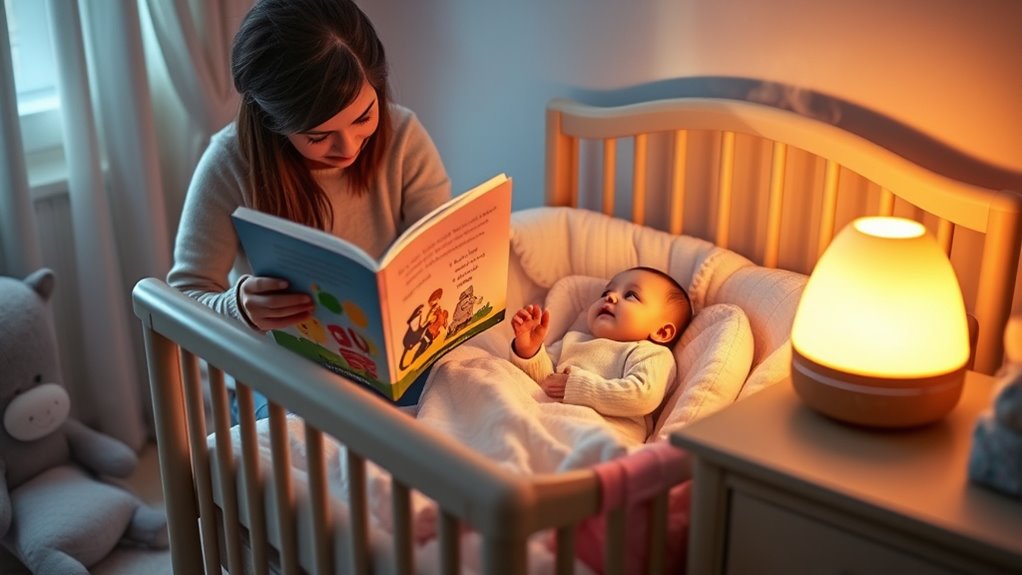To build a bedtime routine your baby loves, start by establishing consistent, calming activities that signal wind-down time, like a warm bath, gentle massage, or soft singing. Create a calming environment with dim lights, quiet sounds, and familiar objects such as a soft blanket or stuffed animal. Stick to the same sequence each night to help your baby associate these cues with sleep, making the shift smoother. Keep exploring to discover more ways to make bedtime a positive experience.
Key Takeaways
- Establish a consistent, calming sequence of activities to signal bedtime and help your baby associate them with sleep.
- Incorporate soothing techniques like gentle singing, baths, or massage to create a relaxing environment.
- Use familiar, safe sleep objects like a soft blanket or stuffed animal to foster comfort and routine recognition.
- Keep the sleep environment calm, dim, and quiet to reinforce sleep cues and reduce overstimulation.
- Follow a regular sleep schedule to develop your baby’s internal clock and make bedtime predictable and enjoyable.

Creating a consistent bedtime routine for your baby can make a big difference in helping them settle down and sleep peacefully through the night. When you establish predictable steps, you help your little one associate certain activities with sleep, which can ease their progression from wakefulness to rest. One of the key elements in doing this is understanding sleep associations—those cues or objects your baby links with sleep, like a favorite blanket or a specific sound. If your baby depends on being rocked or having a bottle to fall asleep, they might struggle to settle without those factors later on. To build a healthy routine, it’s important to gradually introduce calming techniques that promote independent sleep, so your baby learns to soothe themselves without becoming overly reliant on external help.
Calming techniques are your best tools for creating a peaceful environment that signals bedtime. You might start with a warm bath, which not only cleans but also relaxes your baby’s muscles and signals that bedtime is near. Follow this with gentle massage or soft singing, which can lower their stress levels and create a soothing atmosphere. Dimming the lights and reducing noise can further reinforce the shift from daytime activity to nighttime rest. Consistency is key—if you do these activities in the same order every night, your baby will begin to understand that sleep is approaching. Over time, these calming activities become sleep associations, making it easier for your baby to settle down even if they wake during the night. Incorporating a calming environment with consistent cues helps reinforce sleep readiness and comfort. Additionally, maintaining a sleep schedule helps your baby’s internal clock develop, making it easier for them to fall asleep naturally. Establishing a predictable routine also encourages your baby to develop healthy sleep habits, which are essential for their overall development.
Introducing a consistent bedtime ritual can further enhance their understanding of when it’s time to sleep. It’s helpful to introduce a familiar, calming object, like a small stuffed animal or a soft blanket, to serve as a sleep association. These objects can provide comfort and reassurance, especially if your baby wakes up in the middle of the night. Just make sure the object is safe for their age. You should also aim to keep the environment consistent—dim lights, quiet room, and a comfortable temperature—so your baby’s body recognizes that it’s time to wind down. Avoid overstimulating activities close to bedtime, as they can make it harder for your baby to relax.
Frequently Asked Questions
When Should I Start Establishing a Bedtime Routine?
You should start establishing a bedtime routine as early as 4 to 6 weeks old, when your baby adapts best to consistent cues. Incorporate gentle sleep training and smooth nap transitions, which help signal sleep time. Consistency is key, so begin now to set a foundation for healthy sleep habits. By establishing a routine early, you’ll make bedtime easier and guarantee your baby feels secure and ready for restful sleep.
How Do I Handle Bedtime Resistance or Tantrums?
Imagine bedtime as a gentle river, flowing smoothly, even when resistance tries to create rapids. When your baby tantrums, remember bedtime myths that say they’re stubborn—it’s normal. Use soothing techniques like soft singing or gentle rocking to calm the storm. Stay patient, steady, and consistent, guiding your little one back to tranquility. With love and understanding, you’ll help them feel safe and ready to drift into peaceful sleep.
What if My Baby’S Sleep Schedule Changes Frequently?
When your baby’s sleep schedule changes frequently, it’s often due to sleep regressions or teething discomforts. You can help by maintaining a consistent bedtime routine, even during these fluctuations. Offer extra comfort and patience, and adjust nap times if needed. Keep the environment calming, and try to stick to familiar activities. This consistency reassures your baby, easing them through these temporary disruptions and helping establish a stable sleep pattern.
Can a Bedtime Routine Help With Early Waking?
Yes, a consistent bedtime routine can help with early waking. You create a calming sleep environment and use soothing techniques, like gentle rocking or soft music, to signal bedtime. This helps your baby associate these cues with sleep, encouraging longer rest. Over time, this routine trains your baby’s internal clock, reducing early waking and improving overall sleep quality for both of you.
How Do I Adjust the Routine During Travel or Vacations?
When travel calls for a change in your little one’s sleep schedule, it’s wise to embrace routine flexibility like a gentle breeze. Use travel tips to keep bedtime calming and consistent, even in new surroundings. Stick to familiar cues, adapt your routine smoothly, and prioritize comfort. This way, your baby feels secure, and you maintain a soothing atmosphere, making nights peaceful despite the change in scenery.
Conclusion
Creating a bedtime routine your baby loves can feel like opening the secret to peaceful nights—it’s truly a game-changer. When you stick to a consistent, soothing schedule, you’ll notice your little one settle down faster than you ever imagined. Embrace these special moments, and soon, bedtime will become the highlight of your day. With patience and love, you’ll turn bedtime into a cozy, magical experience that brings joy to both of you—night after night.









